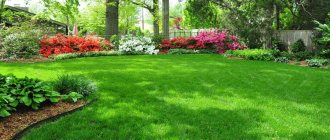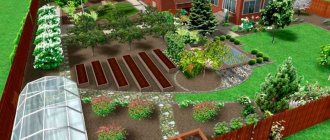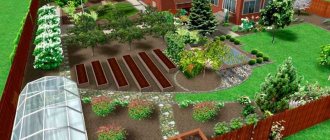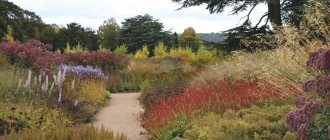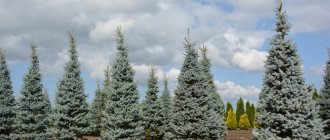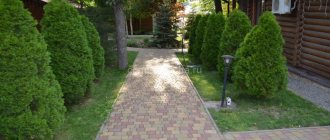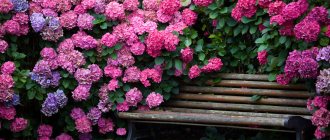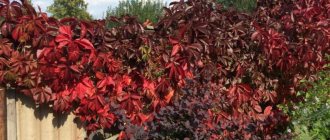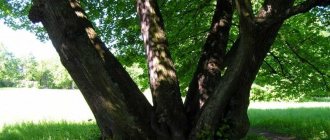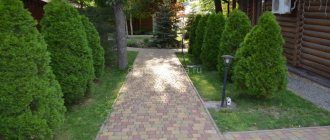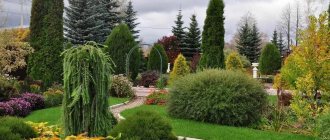Even on a small plot you can fit a house, a garden with a vegetable garden, and a flower garden. A landscape composition can be composed not only of ornamental plants, but also of fruit trees. After all, with the right layout, they look no worse.
Fruit trees are rarely used in landscape design, since there are many ornamental shrubs and trees that can create an attractive composition on a site. But don’t write off fruit trees: they can add their own flavor to a design. And now we will prove it!
Types of fruiting trees and shrubs
The main place in the dacha landscape is occupied by decorative foliage plants and flowers. But if desired and in suitable natural conditions, you can plant both fruit trees and shrubs. It is recommended to plant them in groups or in a checkerboard pattern, without mixing stone fruit and pome species.
The following trees and shrubs are popular among gardeners:
- Apple tree;
- plum;
- cherry;
- pear;
- cherries:
- honeysuckle;
- barberry;
- chokeberry;
- sea buckthorn;
- irga.
The most favorite types of garden crops are apple trees, cherries and plums. They are valued not only for their delicious fruits: trees blooming in spring decorate the garden, saturating the air with a subtle, unique aroma.
Apple blossom
In warm climate zones, many cultivate cherry, mulberry, and walnut bushes. Breeders have developed varieties that can bear fruit in more northern regions. When purchasing a plant, you should take into account its adaptability to adverse weather conditions.
Certain varieties of raspberries, gooseberries, red and black currants, adapted to the short northern summer, tolerate low temperatures well. Shrubs take root faster and easier in a new place , they look original along the fence of the site, fitting into the modern landscape. Less popular, but no less remarkable, are other fruit trees and shrubs: barberry, lemongrass, rowan, hazelnut.
One of the most common and unpretentious fruit shrubs is raspberries.
Any of the listed types of plants needs certain conditions: the amount of free space, uniformity of illumination, groundwater level, soil acidity, etc. For some representatives of the flora, the presence of several varieties of the same species is necessary for the formation of ovaries.
In addition, fruit-bearing crops are especially demanding in terms of timely fertilizing. The soil around the plants should be soft, for which it is recommended to regularly loosen it and remove weeds. To create favorable conditions for fruiting, trees and shrubs need to prune old branches. The formation of the crown allows you to give the plants the desired shape, combined with the decorative elements of the site, which is especially important in the presence of crafts, sculptures, and compositional groups. In addition, this operation saves the garden from excessive thickening.
Expert advice: how to care for fruit trees (video)
How to build beautiful beds and place them correctly in your garden
Formats
They can be of all kinds; their size can only be limited by the dimensions of the site. The ridges can be built straight or of various geometries, or figured. You can provide a fence, or you can do without it; they can be low or high in height.
Planting strawberries
High ridges are now more in demand. Of these, the most successful are those that reach a height of 40 cm. Bases:
- Such ridges are warm. A layer of materials that compost more slowly (leaves, weeds, paper waste) is placed on the bottom layer of materials that compost quickly (branches, rags, paper, cardboard). Then you should spill it with water and cover it with soil. During the process of decay, the ridge will begin to release heat, and the crops will ripen more actively.
- The sun's rays will warm the soil more actively. But irrigation also needs to be done more often.
- If you want to protect your future harvest from moles and mice, you should place a plaster mesh under the bottom layer.
- Such ridges do not require digging. After all, they are not dug, but made.
- It is possible to harvest crops twice per season. You can also have time to grow, for example, lettuce before planting the main crop.
Dimension
As usual, the ridges are from half a meter to a meter wide. These dimensions are suitable for processing, as they make maintenance easier. And the length can not be limited. According to Mitlider’s method, it is proposed to construct completely narrow ridges of 45 cm, and the passages, on the contrary, are wider at 90 cm, while the length of the ridges should not exceed 9 meters. Gardeners who use this technique speak positively about it.
The vegetation is well ventilated. As it grows, accessibility to it remains especially comfortable, and most importantly, it receives the energy of the sun in greater quantities, and even in the cloudy summer season the fruits ripen perfectly. Yields in this variation increase.
A variety of crops can be planted in the beds built by this species: tomato, cucumber, cabbage, eggplant, pepper, etc.
Location
As usual, the ridges are arranged from the south side in a northerly direction. This allows all vegetation to warm up evenly. And in the morning and evening, when the sun’s rays illuminate the ridges from the sides, they do not particularly shade each other. It happens that the site is endowed with a slope. How to correctly arrange the ridges in this option?
It is better to place them across the slope, then the moisture will be evenly distributed. It happens that the site is completely uneven, in which case it is recommended to place the ridges on the slope on the south side, and garden vegetation on the north side.
Layout
For its literacy you need to consider:
- The yield of one or another varietal type of vegetable per square meter. After all, then it will be possible to calculate the required landing site for each species.
- Vegetation compatibility. Without it, it will not be possible to carry out the plan efficiently.
- If the site is too sloping, it is necessary to build terraces and place ridge boxes on them.
- Plan planting of crops so that taller vegetation is on the northern side of the site. This way, lower species will not grow in shade.
Orchard decoration
Having outlined an approximate list of desired trees and shrubs for the garden, having studied the conditions for favorable growth and fruiting of each species, you should not immediately run to the nearest nursery or specialty store for shopping.
It is necessary to draw up a scheme for planting plants, taking into account their individual characteristics, and roughly outline the promising structure of compositions from individual bushes or trees.
Do not forget about the functional purpose of fruit crops: to care for them and obtain a harvest, it is necessary to prepare the soil, i.e. dig up and fertilize it.
Quince
Optimal planning of a garden plot (garden sculptures, decorative and aesthetic elements) involves taking into account the following factors:
- location of a residential building, outbuildings;
- planting scheme for different types of vegetation;
- proposed placement of fruit crops;
- the presence of small architectural forms (gazebos, wells, places for recreation, etc.);
- garden paths;
- decorative elements (garden sculptures, handmade country crafts, etc.).
The basic principle of landscape design involves the arrangement of fruit and berry crops along alleys, in groups, single plants, and also as a hedge.
Apple orchard
Various paths and paths are an ideal solution for a large garden. With their help, you can intelligently divide the territory into separate zones: secret shady corners, convenient viewing platforms, green sunny lawns.
The presence of a single large tree on a sufficiently large area becomes, as a rule, the compositional center of the landscape. Most often, this way, interesting relief features are highlighted, which can be emphasized with decorative finishing made of natural stone. If you place wicker garden furniture on the lawn under a branchy tree, you will get a cozy place to relax and receive guests in the fresh air.
Barberry hedge
Fruit bushes are usually used to construct hedges. The overgrown vines not only cover the internal territory from prying eyes, but also create an original design of the boundaries of the site.
Choosing a place for garden crops
In order for fruit trees and bushes not only to please the eye with their beauty, but also to bear fruit, it is necessary to protect them from adverse environmental influences. First of all, you should pay attention to the following factors:
- Relief of the site. It is advisable to locate all fruit-bearing crops on plains and hills: they prefer an abundance of sunlight and free air circulation. Lowlands can be played up in a imaginative way by outlining garden sculptures, decorative crafts, artificial ponds with benches, etc. when planning a garden plot.
- Groundwater level. The minimum permissible depth should be at least 80 cm. The shorter the roots, the closer to the surface the groundwater should be. Therefore, planting of berry bushes is carried out where the soil is the most moist. If it is planned to plant fruit trees in this place, the ground level must be artificially raised.
- Soil composition. Garden trees and shrubs require fertile soil - black soil or gray soil. If the site is dominated by clay, sandy or rocky soil, the soil should be enriched by adding high-quality soil with a predominance of organic components.
Before planning an orchard, it is necessary to determine how much space is required for a particular crop. In small areas it is better to plant 1 fruit-bearing tree, for example, an apple tree. As its crown grows, it will take up more and more space. In its shade you can create an excellent shady corner for relaxation. Berry bushes will look good along the perimeter of the site.
Flower beds near trees
Around mature single fruit trees you can lay out a lawn, mini-flower beds, and mixborders. To decorate a tree-trunk circle of earth with a radius of 1-1.5 m, coniferous shrubs and perennial shade-loving flowers are most often used. But under the young seedling, the nearby plot of land needs to be regularly weeded for the first 2-3 years, removing weeds. Only when the tree reaches 4-5 years of age can you begin to arrange flower beds in the tree trunk area.
Site preparation
In order for trees to grow well, the soil must be fertilized and prepared in a special way, no matter how good it is.
Instructions for performing this work are as follows:
- First of all, the area must be fertilized with peat or manure. One and a half to two buckets of fertilizer per square meter should be applied per square meter.
- Then the area needs to be dug up to the depth of a spade bayonet. It is advisable to perform this procedure in the fall.
- If the soil is acidic, you need to scatter ground limestone on its surface and mix it with the soil.
- In the spring, the area must be dug up again and leveled with a rake.
After completing these procedures, you can begin planting.
Decorative elements in the design of an orchard
By decorating your garden area with fruit trees, you can realize your own fantasies by placing your own handmade crafts on the site. Some people make figures of birds and animals, others decorate the walls with drawings. Original flower beds, real alpine slides in the shade of old fruit trees, will look great.
Even from a fallen trunk you can make an original flowerbed: a flowering log will delight the eye throughout the entire season if you hollow out the core, fill it with soil and plant several types of annuals.
Landscape design is not limited to a flat English lawn with individual, strictly verified inclusions. First of all, individuality in the design of the site is valued. Therefore, hand-made or purchased crafts, sculptures, small decorative forms and structures will only give the backyard a unique look. The main thing is that all objects are designed in the same style and combine with each other: a crane near a well, figures made of rubber tires near a cherry tree, a carved bench under an apple tree, etc.
Get creative and use old things for flower beds
An orchard on a summer cottage does not necessarily have to produce tons of harvest - after all, its main role is decorative. Therefore, the minimum distance between trees should be 4-6 m. It is permissible to fill the gaps with berry bushes. The decor will be complemented by a variety of handmade crafts. Such a tiered landscape design will allow you to harmoniously realize the idea of your own orchard even in a small area.
Flowerbed of perennials
The transition between the upper and lower terraces is decorated with a flower bed of perennials. Plants are selected in such a way that flowering is continuous.
This is what a flower bed looks like in the spring after planting
In April-May, bulbous irises bloom. In June-August - brilliant rudbeckia, purple coneflower, lilies of various varieties, hostas. In September-November, garden chrysanthemum and alpine aster delight the eye.
Autumn flower bed (after 4 months)
Blooming flowerbed in May (a year after planting)
